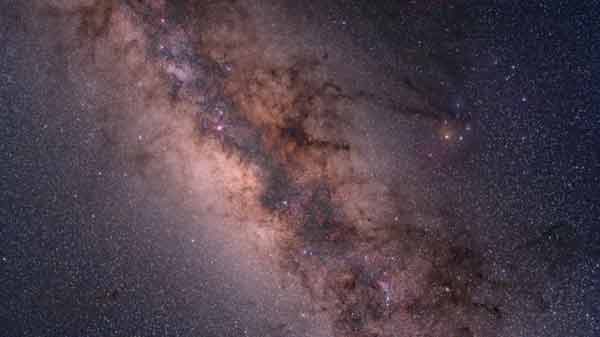
California, US (BBN) - A small but distinctive signal in X-rays from the Milky Way could be key to proving the existence of dark matter.
That is the claim of US scientists who analysed the energy spectrum of X-rays gathered by Nasa's Chandra satellite, reports BBC.
They found more X-ray photons with a particular energy than would be expected if they were produced only by familiar processes.
Those photons could in fact have been generated by the decay of dark matter particles, say the researchers.
This is not the first time that scientists have seen extra photons with an energy of about 3,500 electronvolts (3.5 keV) in the spectra recorded by X-ray satellites.
But previously, according to Kevork Abazajian, a cosmologist at the University of California, Irvine, it was not clear whether the bump, or "line", created by the photons in the otherwise smooth spectrum was merely an instrumental artefact.
"This result is very exciting," said Dr Abazajian, who was not involved in the research. "It makes it more likely that the line is due to dark matter."
Scientists reckon that dark matter makes up more than 80 per cent of all the mass in the Universe.
As its name suggests, it gives off no light, but reveals its presence through the gravitational tug it exerts on stars within galaxies.
However, we still have little idea about what dark matter actually is.
For years, physicists have been trying to detect particles of dark matter directly by intercepting them using instruments on Earth.
But, so far, those experiments have drawn a blank.
Meanwhile, astrophysicists have been scouring the sky for the photons generated when dark matter particles either annihilate with one another or decay.
So-called weakly-interacting massive particles (WIMPs) are believed by some researchers to be responsible for unusual emissions of gamma rays seen coming from the centre of the Milky Way.
Others, however, think more mundane sources such as pulsars are probably the cause.
The latest research, which targets relatively light particles of dark matter, has been carried out by Nico Cappelluti of the Yale Center for Astronomy and Astrophysics in Connecticut, US, and colleagues.
Cappelluti's co-worker Esra Bulbul of the Kavli Institute for Astrophysics and Space Research at the Massachusetts Institute of Technology (MIT) was the first scientist to spot an anomalous line at 3.5 keV, when looking at the X-ray spectra of large numbers of galaxy clusters in 2014.
Since then, other groups have seen a line with the same energy in spectra from a variety of other objects, including the Andromeda and Milky Way galaxies.
As they describe in a paper posted to the Arxiv preprint server, Cappelluti and colleagues studied the X-rays arriving at the Chandra observatory from two regions of the Milky Way far from the galactic centre.
Like other galaxies, the Milky Way is thought to be enveloped in a bubble of dark matter.
The researchers found that the strength of their 3.5 keV signal was consistent with data from another Nasa X-ray satellite, the Nuclear Spectroscopic Telescope Array (NuStar).
Given no obvious sources of interference within the satellite itself, the researchers concluded that the signal is unlikely to be caused by instrumental noise.
To then establish whether dark matter could be the culprit, they compared Chandra's spectra to those of X-rays from the centre of the Milky Way that had been detected by the European Space Agency's XMM-Newton satellite.
As expected, they found the signal in the latter to be stronger, given that dark matter should be densest where there are more stars - in the galactic centre.
The researchers also ruled out a couple of alternative astrophysical sources for the signal: photons emitted either when very large black holes suck in material from their surroundings or when ions of sulphur take electrons from hydrogen in the centre of galaxy clusters.
"We found that our result is consistent with previous results if you assume the cause to be dark matter," said Dr Bulbul.
The researchers are not yet ready to claim discovery of dark matter because, they say, it is still possible that their result is a statistical fluke - that Chandra just happened to snare more X-rays with an energy of 3.5 keV than it did others.
But they are heartened by the fact that four different satellites have now seen the same signal.
"As we collect more and more X-ray data, the evidence for the 3.5 keV line is growing and growing," said Dr Cappelluti.
Others, however, urge caution. Dan Hooper, a particle theorist at Fermilab near Chicago, points out that a number of other studies have failed to see the line, including one by a group analysing data from the Japanese space agency's (Jaxa) ill-fated Hitomi X-ray satellite.
Hitomi malfunctioned just over a month after launch in February last year, but managed to collect enough data to disprove a previously claimed sighting of the 3.5 keV line in the Perseus galaxy cluster.
"The new paper claims a modest detection," said Dr Hooper, "but it doesn't sway me very strongly at this point."
Christoph Weniger, a theoretical astroparticle physicist at the University of Amsterdam, is a little more upbeat, arguing that the new research "adds yet another piece to the 3.5 keV puzzle".
He said that the signal might be due to a hypothetical particle known as the sterile neutrino, which would decay into an X-ray photon and a normal neutrino.
But he stressed the need for more data to "confirm or reject the dark matter hypothesis".
Such data might come from a replacement for Hitomi. According to Robert Petre of Nasa, funding for an "X-ray Astronomy Recovery Mission" is currently being discussed by the Japanese government.
Work on the new mission could start as soon as April, he says, with lift-off then potentially taking place in 2021.
BBN/MS/SK